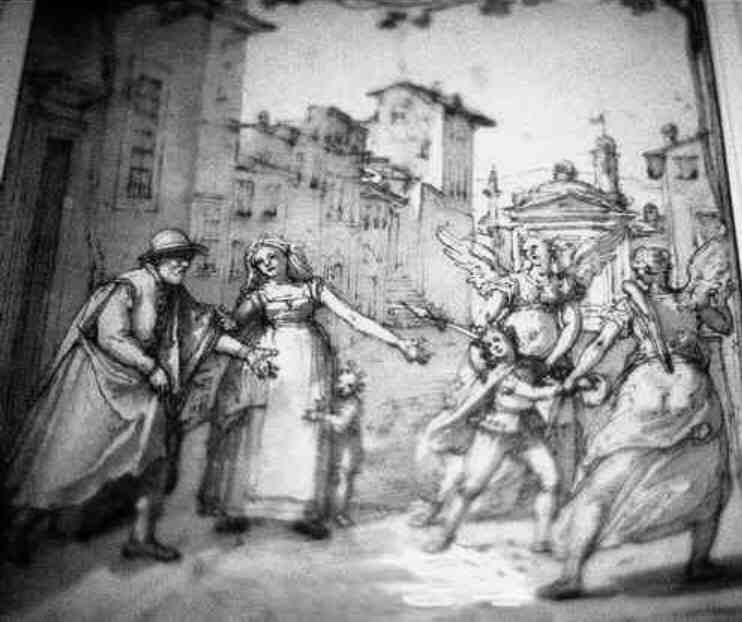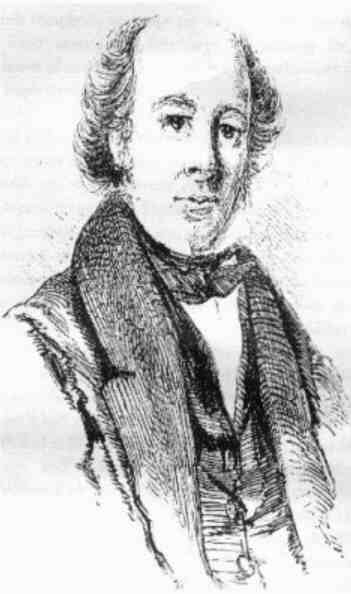^
Died on 01 September 1666: Frans I. Hals,
Haarlem portraitist born between 1581 and 1585.
— He was born in Antwerp, the son of Flemish parents who moved to Holland
after the city fell to the Spaniards in 1585. His parents had settled in
Haarlem by 1591 and he spent his long life there. He was twice married,
had at least ten childred, and was constantly in financial trouble. Houbraken
says he was `filled to the girls every evening', but there is no real foundation
for the popular image of him as a drunken wife-beater. His second wife,
however, was more than once in trouble for brawling. During his last years
he was destitute and the municipal authorities of Haarlem awarded him a
small annuan stipend four years before his death.
Hals was the first great artist of the 17th-century
Dutch school and is regarded as one of the most brilliant of all portraitists.
Almost all his works are portraits and even those that are not (some genre
scenes, and an occasional religious picture) are portrait-like in character.
He is said to have been taught in Haarlem by Karel van Mander, but there
is no discernible influence from him in Hals's early works, which are not
numerous or well documented.
The earliest extant picture is the fragment
of a portrait Jacobus Zaffius (1611), and upon the basis of stylistic
evidence one or two paintings can be dated a year or so earlier. Nothing
he did before 1616 suggested that he would shatter well-established traditions
with his life-size group portrait The Banquet of the Officers of the
St George Militia Company painted during that year. There is no precedent
in either his own work or that of his predecessors for the vigorous composition
and characterization of this picture, which has become a symbol of the strength
and healthy optimism of the men who established the new Dutch Republic.
It demonstrates to the full his remarkable ability — his greatest gift
as a portraitist — to capture a sense of fleeting movement and expression
and thereby convey a compelling feeling of vivacity.
From 1616 onwards there is no shortage of
dated or documented works and his artistic development is clear. He was
at the height of his popularity in the 1620s and 1630s. During these decades
he made five large group portraits of civil guards; one is in the Rijksmuseum
and the others are in the Frans Hals Museum, Haarlem, the only place where
one can get a comprehensive view of his range and power.
In the 1630s his compositions became simpler
and monochromatic effects took the place of the bright colors of the earlier
paintings (Lucas de Clercq and Feyntje van Steenkiste
(1635). The group portrait of the Regents of the St Elizabeth Hospital
(1641) sets the key for the sober restraint of the late period, when his
pictures became darker and his brush-strokes more economical. The culmination
of this phase — indeed of his entire career — are his group portraits
of the Regents and the Regentesses of the Old Men's Alms House
(1664), which rank among the most moving portraits ever painted. By this
time Hals was using in his commissioned portraits the bold brushwork and
the alla prima technique which early in his career he reserved
for genre pictures. No drawings by him are known and he presumably worked
straight on to the canvas.
Hals had two painter brothers and five painter
sons, but the only artist of substance among them was his brother Dirk
(1591-1656), who painted charming small interior scenes. Apart from his
sons, Hals taught numerous students, including (with varying degrees of certainty)
Judith
Leyster, Jan
Miense Molenaer, Adriaen
van Ostade, Adriaen
Brouwer, and Philips
Wouwerman.
His reputation did not long outlive him,
however, and with rare exceptions — Reynolds was one of them —
few critics before 1850 praised him. It was only in the second half of the
19th century that there was a renewed appreciation of his genius. The spontaneity
of his work appealed to the generation of the Impressionists,
and from about 1870 to about 1920 he was one of the most popular of the
Old Masters, becoming a model for society portraitists. Lord Hertford's
purchase of his most famous work, The Laughing Cavalier (1624),
for the then enormous sum of 51'000 francs in 1865, was a milestone in the
revival of his fortunes, and the buoyant confidence of his paintings later
made him a particular favorite with the new generation of fabulously rich
US collectors — self-made men — who were beginning to dominate
the picture market. This explains why so many works by him are in US collections.
— Frans Hals was one of the greatest portraitists, much admired for
his brilliant lighting effects and the freedom of his brushwork. Hals was
born in Antwerp, Belgium, and probably trained by the Dutch painter Karel
van Mander (1548~1606). He spent all of his adult life in Haarlem, the
Netherlands, finding patronage with the wealthy middle-class merchants and
burghers of his time. Throughout his life he received important commissions
for group portraits of the officers and corporations of Haarlem; toward
the end of his life he was granted a small pension by the city. He died
September 1, 1666, in what is now the Frans Hals Museum in Haarlem.
In all of his portraits Hals achieved an
air of complete spontaneity; his subjects give the impression of being caught
in a fleeting, but characteristic, pose and expression. The gay mood of
the early work The Laughing Cavalier (1624), the subject's apparently
momentary smile and stance, demonstrate Hals's ability to attain the immediacy
of a sketch by the use of rapid, spontaneous brushstrokes. The broad brushstroke
is characteristic of his work and adds a robust and lively quality to his
portraits, particularly to the genre or character pieces he painted from
1620 to 1640. One of the most famous, the portrait of the gypsy tavern girl
La bohémienne (1630) owes its gaiety and brightness to two other
painting techniques Hals employed: fully illuminating the figures with direct
light, and blending the brilliant colors directly on the canvas.
Although his portraits appear spontaneous
and uncalculated, Hals was an expert technician, and his studies are always
skillfully composed. His talent is particularly evident in his nine group
portraits of the burgher guards and corporations of Haarlem, all of which
are now in the Frans Hals Museum. In these group portraits Hals demonstrates
his ability to catch each man in a characteristic pose, thus giving the
group an air of informality and naturalness; each individual is clearly
portrayed, yet all are linked in a well-balanced pattern in line and color.
As his style matured, Hals replaced the bright colors of his earliest canvases
with a more monochromatic color treatment. In his last group portrait, Regentesses
of the Old Men's Almshouse (1664), he limited his palette to somber
shades of black and gray, relying on broader and more vigorous brushstrokes
to accentuate light and color value. This work is considered his masterpiece,
because the style lends a greater austerity and depth to the study, while
simultaneously it fuses the group into a natural and harmonious pattern.
In this group portrait, Hals achieves a new dignity and feeling for the
character of the subjects that is absent from his earlier works, yet retains
a spontaneous effect by the dexterity and facility of his brushwork.
— Recent research in the Antwerp civic archives has established that
Frans Hals must have been born there about 1582-83, before his parents left
for Haarlem in 1585, when Antwerp was retaken by the Spaniards. The role
of Hals's teacher has been ascribed to the Haarlem artist-biographer Karel
van Mander (1548-1606); however, nothing of that artist's dry mannerism
is discernible in Hals's works. Entering the painters' guild of Haarlem
in 1610, Hals established his reputation as a superb portraitist with the
1616 group portrait The Banquet of the Officers of the Saint George
Civic Guard. Hals's portraits depict prosperous individuals and civic
groups of Haarlem and other Dutch cities, as well as prominent thinkers
of the day, such as René Descartes, whose portrait Hals painted in
1649. Hals was the leading artistic personality in Haarlem, attracting many
students including Adriaen Brouwer, Judith Leyster, and Philips Wouwermans
However, not until the mid-nineteenth century were Hals's originality and
technical skill fully recognized. In fact, during his later years, mounting
debts forced him to apply to the city of Haarlem for a small annual pension
to allow him to meet even his modest living expenses.
— LINKS
— Portrait
of a Gentleman in White (1637, 69x59cm)
— Company
of Captain Reinier Reael (The Meagre Company) (1637)
— Marriage
Portrait of Isaac Massa and Beatrix van der Laen (1622)
— Portrait
of a man, possibly Nicolaes Hasselaer (1632)
— Portrait
of a woman, possibly Sara Wolphaerts van Diemen (1632)
— The
Merry Drinker (1629) — Gypsy
Girl — The
Laughing Cavalier (1624, 86x69cm)
— Pieter
van den Broecke (1633, 71x61cm) — Willem
Coymans (1645, 77x64cm)
— Singing
Boy with a Flute (1627) — A Family Group
in a Landscape (1632) |

